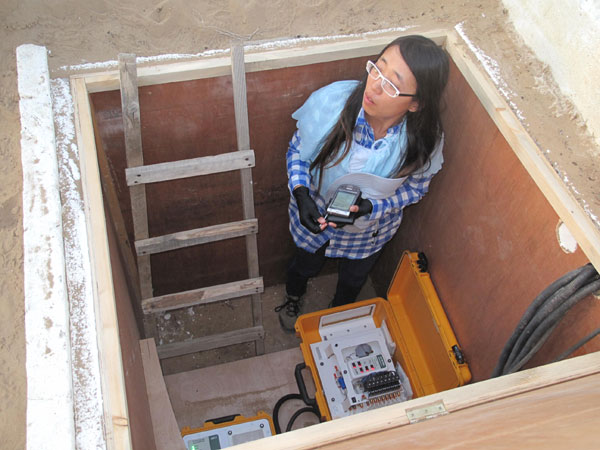 |
| Li Shoujuan, 26, a researcher in the Gurbantunggut Desert, observes the carbon flux of a desert plant. (China Daily) |
Li Shoujuan, 26, has a lonely and sometimes dangerous job.
From April to October, 9 am to 9 pm, Li, a researcher in the Gurbantunggut Desert, China's second-largest, monitors an electronic screen buried deep into the scorching earth.
She is finishing a thesis for her master's degree at the Fukang National Field Scientific Observation and Research Station.
The goal of her experiments is to observe the carbon flux of the desert plant Haloxylon ammodendron, better known as sacsaoul.
"The growing season is the busiest time for me," Li said.
To protect equipment from the baking earth, where the temperature sometimes reaches 80 C, Li buries them.
Li had a close call in August.
"I felt sick in the hole, so I climbed out. But I still felt like I was going to faint. You know, if I had fainted it would have been very dangerous. No one would know before 9 pm."
She had her wits about her, found shade nearby under a shrub, and managed to call the station.
Once a month she has to stay in the desert overnight for data observation.
"Normally, somebody comes to join me to share the experience of being in the desert at night under a blanket of stars."
Li confessed that she did not know the working conditions would be so tough.
Some of Li's fellow students have a more cosmopolitan life with plenty of time spent traveling and attending lectures.
"I used to admire them, but the longer I do research, the more I find that I like it here," she said.
Getting back to normal could be hard, she admits.
After she earns her master's degree, Li plans to continue to study and work in the Gurbantunggut Desert.
 Pakistan suffers desperate shortage of water
Pakistan suffers desperate shortage of water Lanzhou MAC conducts actual-troop live-ammunition drill
Lanzhou MAC conducts actual-troop live-ammunition drill Heritage train ride across western Kosovo
Heritage train ride across western Kosovo Heavy rain hits Hangzhou, causing traffic jam
Heavy rain hits Hangzhou, causing traffic jam Students wade through water to school
Students wade through water to school Dabaiyi wedding ceremony in China's Yunnan
Dabaiyi wedding ceremony in China's Yunnan Harbin named Chinese city with most beautiful women
Harbin named Chinese city with most beautiful women Weekly Sports Photos: Bale transfers to Real Madrid
Weekly Sports Photos: Bale transfers to Real Madrid Funniest photos of sport stars as kids
Funniest photos of sport stars as kids  Residences of the royal house of Savoy
Residences of the royal house of Savoy China's frigate 'Bengbu'in fire training
China's frigate 'Bengbu'in fire training The last days of Wan Aihua
The last days of Wan Aihua Highlights at 12th National Games of China
Highlights at 12th National Games of China Beijing Film Academy welcomes freshmen
Beijing Film Academy welcomes freshmen 2013 Taiwan Int'l Tourism Expo kicks off in Taipei
2013 Taiwan Int'l Tourism Expo kicks off in TaipeiDay|Week|Month